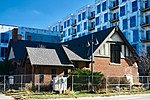St. Mary's Rectory (Iowa City, Iowa)
Greek Revival houses in IowaHouses completed in 1854Houses in Iowa City, IowaHouses on the National Register of Historic Places in IowaNational Register of Historic Places in Iowa City, Iowa ... and 1 more
Roman Catholic Diocese of Davenport

The former St. Mary's Rectory is a historic building located in Iowa City, Iowa, United States. Now a private home, the residence housed the Catholic clergy that served St. Mary's Catholic Church from 1854 to 1892. At that time the house was located next to the church, which is four blocks to the west. It was listed on the National Register of Historic Places in 1995.
Excerpt from the Wikipedia article St. Mary's Rectory (Iowa City, Iowa) (License: CC BY-SA 3.0, Authors, Images).St. Mary's Rectory (Iowa City, Iowa)
East Jefferson Street, Iowa City
Geographical coordinates (GPS) Address Nearby Places Show on map
Geographical coordinates (GPS)
| Latitude | Longitude |
|---|---|
| N 41.662694444444 ° | E -91.526722222222 ° |
Address
Public Policy Research Building
East Jefferson Street 605
52240 Iowa City
Iowa, United States
Open on Google Maps










